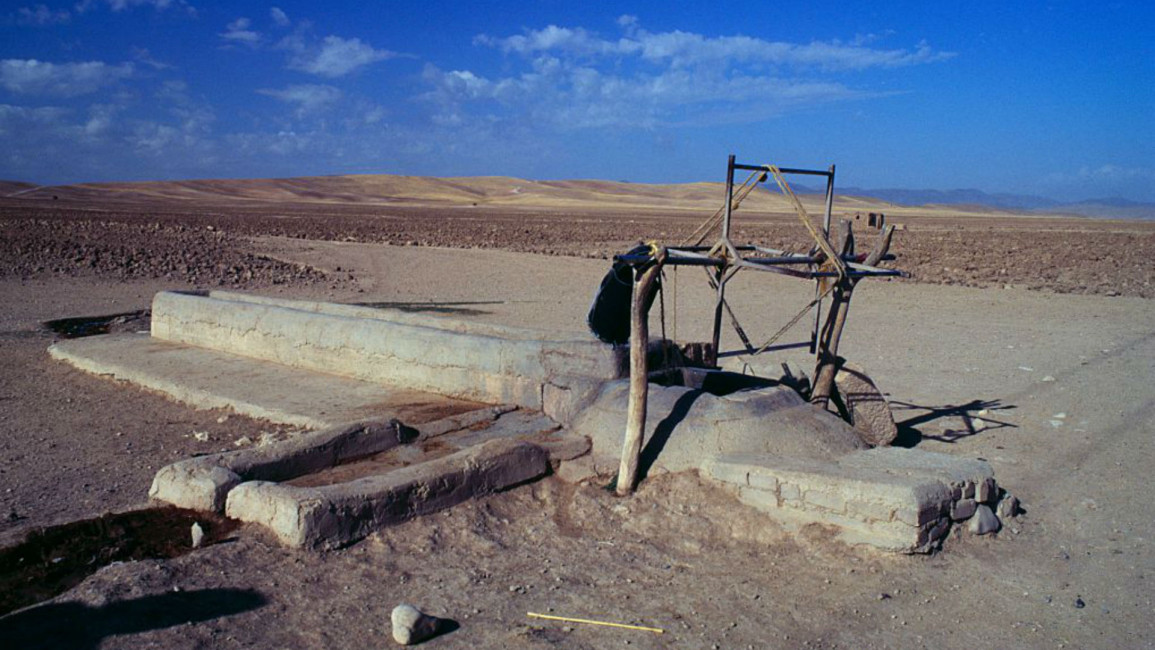
In Iran's oil-rich Gheyzanieh, residents don't even have access to water
Gheyzanieh province boasts a population of 25,000 and is located 40 kilometres east of Ahvaz, the capital of Khuzestan Province. It hosts the largest petroleum companies of Iran, and produces 2 million barrels of crude oil per day. The district sits on upwards of 600 oil wells. The majority of Gheyzanieh residents are farmers or have agricultural jobs.
On 23 May, groups of Gheyzanieh residents gathered in front of the local governor's office and blocked the Gheyzanieh-Ahvaz road with burning tyres, protesting the incessant lack of drinking water, 10 days after tankers which used to supply their water stopped commuting to the impoverished area.
Police responded by firing tear gas and rubber bullets and arrested two demonstrators, and photos of a young man with a severely wounded, bleeding leg went viral on social media.
The governor of Khuzestan apologised to the local residents and promised that the problem will be solved "within two weeks". However, he was likely whitewashing a negligence that is now more than 15 years old, and rehashing a tedious promise the local residents don't believe anymore.
 |
Khuzestan's share from its plentiful oil revenues has been close to zero |  |
Gholamreza Shariati, the governor, whose name is also implicated in a major corruption case currently under investigation by Iran's judiciary, promised in December 2016 that the water shortage of Gheyzanieh would be remedied and solved "within three months". That pledge was never fulfilled.
Khuzestan is the nerve center of oil business in Iran, and produces roughly 80 percent of the country's crude. It also accounts for nearly all of the nation's natural gas production. Being an excessively oil dependent state, Iran relies heavily on Khuzestan for its day to day survival. Despite this, Khuzestan's share from the plentiful oil revenues Iran has earned in the recent couple of decades has been close to zero - nothing but destitution, destruction of agriculture, recession and forced migration of its residents to other parts of the country.
Nearly 3 million Iranian Arabs are estimated to inhabit the province of Khuzestan. They are mostly Shia, but there is also a sizeable Sunni majority. Like other Iranian minorities such as Azeris, Kurds, Lurs, Balochis, Turkmens and Gilaks, they continue to endure the agony of being ignored by the authorities who don't prioritize their concerns and don't minister to their demands.
The Iranian government, as a rule, doesn't put significant monetary resources into improving infrastructure, education and healthcare in peripheral provinces. The majority of resources are centralised in the capital, Tehran, and as a result, border provinces such as Sistan and Baluchestan, Kermanshah, Hormozgan, Kurdistan and Bushehr, share many of the challenges that Khuzestan grapples with. These include water shortages, unemployment, a lack of educational opportunities and low literacy rates, limited electricity supply, unsafe roads and inadequate hospitals and medical centres.
Twitter Post
|
While little money is spent in the provinces, the lion's share of the national budget goes to sustaining ideological causes, such as training clerics in seminaries in Qom, Mashhad and other cities, and funding powerful entities such as the Islamic Development Organization.
Moreover, substantial sums are expended on furthering Iran's foreign policy missions, including strengthening its foothold in Iraq, Lebanon, Palestine and Syria.
In remarks which vividly lay bare the mentality of Iranian government concerning its regional policy, Mehdi Taeb, a prominent hardline cleric and the head of Ammar cultural headquarters said in February 2013, "if the enemy attacks us and is intent on occupying either Syria or Khuzestan, the priority is to keep Syria."
So, the bottom line is that Khuzestan, despite furnishing much of Iran's wealth, is gripped with geographical misfortune and its remoteness from the capital has put it at disadvantage.
However, this is not the only reason the oil-rich province is suffering. The late Iraqi dictator Saddam Hussein wreaked massive devastation and mayhem across Khuzestan during the eight-year war he initiated against Iran in 1980, and the people of Khuzestan still live with the legacy of those harrowing days.
Saddam Hussein launched 2,008 aerial attacks on different Khuzestan cities, killed 5,435 civilians, ruined more than 23,000 houses, annihilated half of the historical fabric of the city of Dezful, destroyed 15 oil refineries in the city of Abadan and uprooted 7 million fertile palm trees.
Reconstruction efforts started after the conclusion of the war, but have been dismayingly sluggish, mostly caused by the unusual bureaucratic mazes the country has been stuck in for four decades, as well as inadequate funding allocated to the province, and incompetent officials who mostly care for their personal gains rather than serving the public.
And ethnic fault lines should also be factored in when deliberating the causes of Khuzestan's underdevelopment and impoverishment. Beginning in the early 1920s, when the Qajar dynasty was in power, Arab separatists in the province harbored ambitions to separate Khuzestan from Iran and establish an independent republic. They have been embroiled in armed conflicts with the forces of the government from time to time, resulting in numerous deaths, which has in turn fostered their resentment and unleashed new waves of violence and unrest in the region.
 |
Khuzestan is the flashpoint of a brewing humanitarian crisis and its provincial authorities are clearly unqualified to address its anguishes |  |
Some Iran observers suggest that successive governments of Iran, far before the Islamic Republic came into being, have deliberately neglected Khuzestan in an attempt to prevent the country's Arab minority, mostly residing in this province, from being empowered, keeping them instead at the mercy of Tehran. This is a policy the Islamic Republic hasn't reversed.
And Khuzestan hasn't been lucky in environmental terms, either. It has been repeatedly struck by extreme weather conditions, and in 2018 lived through an unprecedented drought, the likes of which had not been seen in some 60 years.
According to the local authorities, 96 percent of the area of Khuzestan was affected by "very extreme drought" and the remaining four percent recorded "extreme drought" in this year. The annual budget apportioned to Khuzestan is not sufficient to tackle the periodic droughts that erode its agriculture and prolong water shortages across its cities and villages.
Unless there is determination at the highest level of leadership in Iran to rebuild and regenerate Khuzestan, the province that is the economic lifeline of the country will continue to suffer and its pains will invariably be consigned to oblivion.
Khuzestan is the flashpoint of a brewing humanitarian crisis and its provincial authorities, including its MPs, are clearly unqualified to address its anguishes.
The water protests in Gheyzanieh merely serve as a reminder to the supreme authorities of the Islamic Republic that Khuzestan needs help, and it should be offered before the crisis is unhealable.
Kourosh Ziabari is an award-winning Iranian journalist and reporter. He is the Iran correspondent of Fair Observer and Asia Times. He is the recipient of a Chevening Award from the UK's Foreign and Commonwealth Office and an American Middle Eastern Network for Dialogue at Stanford Fellowship.
Follow him on Twitter @KZiabari




